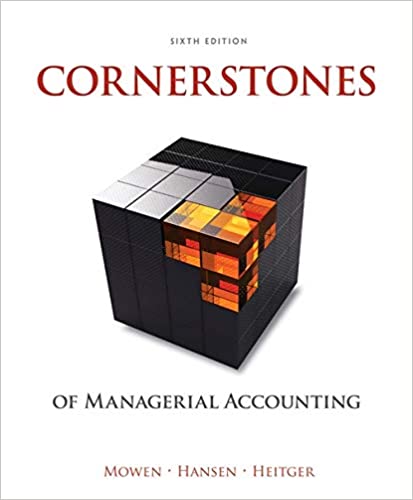
Cornerstones of Managerial Accounting 6th Edition by Maryanne Mowen,Don Hansen ,Dan Heitger
Edition 6ISBN: 978-1305103962
Cornerstones of Managerial Accounting 6th Edition by Maryanne Mowen,Don Hansen ,Dan Heitger
Edition 6ISBN: 978-1305103962 Exercise 55
Weighted Average Method, Separate Materials Cost
Janbo Company produces a variety of stationery products. One product, sealing wax sticks, passes through two processes: blending and molding. The weighted average method is used to account for the costs of production. After blending, the resulting product is sent to the molding department, where it is poured into molds and cooled. The following information relates to the blending process for August:
a. WIP, August 1, had 30,000 pounds, 20% complete. Costs associated with partially completed units were:

b. WIP, August 31, had 50,000 pounds, 40% complete.
c. Units completed and transferred out totaled 480,000 pounds. Costs added during the month were (all inputs are added uniformly):

Required:
1. Prepare (a) a physical flow schedule and (b) an equivalent unit schedule.
2. Calculate the unit cost. (Note: Round to three decimal places.)
3. Compute the cost of EWIP and the cost of goods transferred out.
4. Prepare a cost reconciliation.
5. Suppose that the materials added uniformly in blending are paraffin and pigment and that the manager of the company wants to know how much each of these materials costs per equivalent unit produced. The costs of the materials in BWIP are as follows:

The costs of the materials added during the month are also given:

Prepare an equivalent unit schedule with cost categories for each material. Calculate the cost per unit for each type of material.
Janbo Company produces a variety of stationery products. One product, sealing wax sticks, passes through two processes: blending and molding. The weighted average method is used to account for the costs of production. After blending, the resulting product is sent to the molding department, where it is poured into molds and cooled. The following information relates to the blending process for August:
a. WIP, August 1, had 30,000 pounds, 20% complete. Costs associated with partially completed units were:

b. WIP, August 31, had 50,000 pounds, 40% complete.
c. Units completed and transferred out totaled 480,000 pounds. Costs added during the month were (all inputs are added uniformly):

Required:
1. Prepare (a) a physical flow schedule and (b) an equivalent unit schedule.
2. Calculate the unit cost. (Note: Round to three decimal places.)
3. Compute the cost of EWIP and the cost of goods transferred out.
4. Prepare a cost reconciliation.
5. Suppose that the materials added uniformly in blending are paraffin and pigment and that the manager of the company wants to know how much each of these materials costs per equivalent unit produced. The costs of the materials in BWIP are as follows:

The costs of the materials added during the month are also given:

Prepare an equivalent unit schedule with cost categories for each material. Calculate the cost per unit for each type of material.
Explanation
Weighted average method:
• It summarise...
Cornerstones of Managerial Accounting 6th Edition by Maryanne Mowen,Don Hansen ,Dan Heitger
Why don’t you like this exercise?
Other Minimum 8 character and maximum 255 character
Character 255


